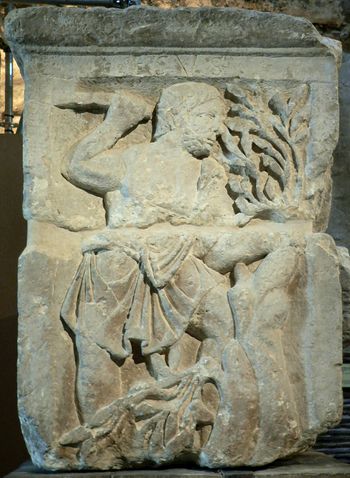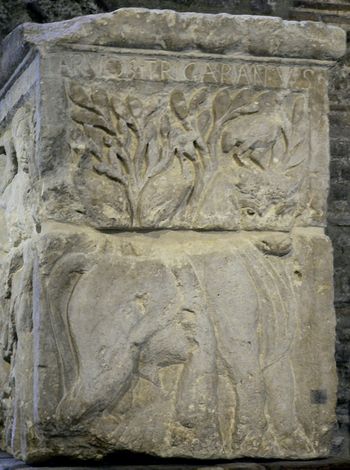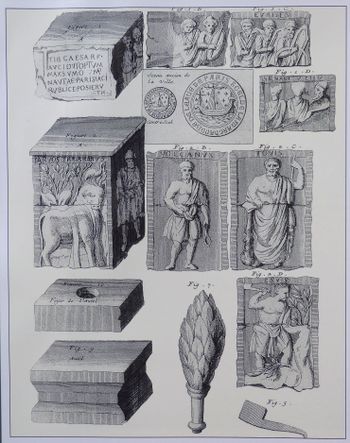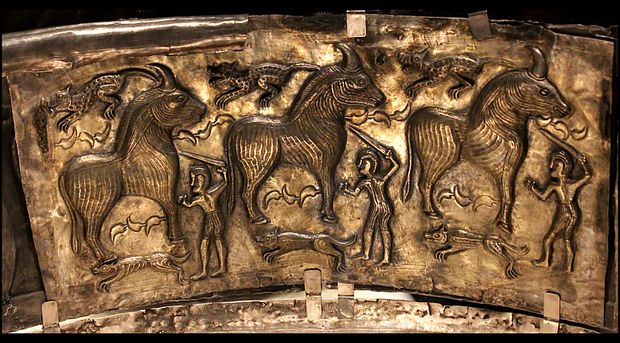「エスス」の版間の差分
| (同じ利用者による、間の59版が非表示) | |||
| 1行目: | 1行目: | ||
| − | [[File:Le Pilier des Nautes 01.jpeg|right|thumb|350px| | + | [[File:Le Pilier des Nautes 01.jpeg|right|thumb|350px|ガロ・ローマ時代の「船乗りの柱」に描かれたエスースの像(紀元1世紀)。[[ヤナギ|柳]]の木を切るエスス。]] |
| + | [[File:Le_Pilier_des_Nautes_03.jpeg|right|thumb|350px|ガロ・ローマ時代の「船乗りの柱」に描かれたタルボス・トリガラノスの像(紀元1世紀)。牡牛と[[柳]]と鶴。]] | ||
| + | [[File:Le_pilier_des_nautes_planche.jpeg|right|thumb|350px|発掘調査で見つかった彫刻のスケッチ、『パリ歴史』第1巻、ミシェル・フェリビエン]] | ||
'''エスス'''(Esus)<ref name="nautae">CIL, 13, 03026</ref>、ヘスス(Hesus)<ref name="phars"/>、あるいはアイサス(Aisus<ref name="marcel"/>)はブリトン人とガリア人の神で、二つの記念像とルカヌスの叙事詩『ファルサリア』の一節で知られている。 | '''エスス'''(Esus)<ref name="nautae">CIL, 13, 03026</ref>、ヘスス(Hesus)<ref name="phars"/>、あるいはアイサス(Aisus<ref name="marcel"/>)はブリトン人とガリア人の神で、二つの記念像とルカヌスの叙事詩『ファルサリア』の一節で知られている。 | ||
| 8行目: | 10行目: | ||
== 図像 == | == 図像 == | ||
| − | + | エススが登場する彫刻は、エススが名指しで描かれたパリの「船乗りの柱」<ref name="nautae"/>と、同様の図像を持つトレヴェリの「トリア」の柱の二つである<ref>Proinsias Mac Cana, Celtic Mythology, Hamlyn Publishing , London, 1970, pages32–35 [http://www.chronarchy.com/esus/aboutesus.html Cited here] (retrieved 2016-08-17).</ref><ref name="miranda">Miranda Green, Symbol & Image in Celtic Religious Art, 1992, Routledge , London , pages103–104</ref>。いずれも、エススは斧で木の枝を切っている姿が描かれている<ref name="miranda"/>。エススは、「船乗りの柱」の別のパネルで、タルボス・トリガラヌス(「三羽の鶴を持つ雄牛」)、ユピテル、ヴァルカン、その他の神々と一緒に描かれている。 | |
| − | == | + | == 文献資料 == |
| − | + | 有名なルカヌスの「ファルサリア」(61-65CE)の一節は、テウタテス、ヘスス(エススの吸引形)、タラニスというケルトの三神に捧げられた痛ましい生け贄について言及している<ref name="phars">M. Annaeus Lucanus (61-65 CE). ''Bellum civile'' I.445.</ref>。ルカヌスの写本には、ヘスス(Hesus)、アイサス(Aesus)、ハエサス(Haesus)など、エススという名前の異表記や読み方がある<ref name="petrone"/>。ルカヌスの作品を解説した後世の二人の論者のうち、一人はテウタテスを水星、エススを火星と同定している。ベルンの『ルカヌス伝』によれば、人間の犠牲者は木に縛られ、鞭で打たれて死ぬことでエススの生贄とされた<ref>Olmsted, Garrett S., The gods of the Celts and the Indo-Europeans, University of Innsbruck, 1994, p. 321.</ref>。 | |
| − | + | ガリア人の医学者ボルデックスのマルケウス(Marcellus of Bordeaux)は、5世紀初頭にラテン語で書かれた薬学的製剤の大要『メディカメンティス(De medicamentis)』において、エススに関するもう一つの文献を提示しているようだ。この作品には、喉の病気を治すためにエスス(アイサスと表記)の助けを求めると思われるガリア語と判読できる魔術的な医学的な呪文が含まれている<ref name="marcel">''De medicamentis'' 15.106, p. 121 in Niedermann's edition; Gustav Must, “A Gaulish Incantation in Marcellus of Bordeaux,” ''Language'' 36 (1960) 193–197; Pierre-Yves Lambert, “Les formules de Marcellus de Bordeaux,” in ''La langue gauloise'' (Éditions Errance 2003), p.179, citing Léon Fleuriot, “Sur quelques textes gaulois,” ''Études celtiques'' 14 (1974) 57–66.</ref>。 | |
| − | == | + | == 解説 == |
| − | + | ジョン・アーノット・マッカロク(John Arnott MacCulloch)は、1911年当時、エススに関する学術的な解釈を次のようにまとめた。 | |
| − | + | <blockquote>M.レイナッハ(M. Reinach)はエススの祭壇の主題を一定の形式で表現している。"The Divine Woodman hews the Tree of the Bull with Three Cranes"(『木こりの神は三羽の鶴と共に雄牛の木を切る。』)全体は未知の神話を表しているが、ダルボア氏はこの中にクー・フーリンの物語(Cúchulainn saga)の内容との関連性を見出している。イメージとしては、牛と木はおそらく両方とも神であり、もしこの動物が神の牛のイメージのように3つの角を持っているとすれば、3羽の鶴(garanus、「鶴」)は、3つの角(trikeras)、あるいはより正確には3頭(trikarenos)のリバスである可能性がある。この場合、木こり、木、牛はすべて植生の神の代表かもしれない<ref group="私注">これは違うと思う。木こりの神は[[桂男]]、牛、木、鳥は中国的な月桂樹でもあり死んだ蚩尤の象徴というべきと考える。木こりと切られるものが「別のもの」である点が大きな問題となっていると感じる。</ref>。初期の儀式では、豊穣を確保するために、人間や動物、樹木などの神の代表を定期的に破壊したが、神がこれらの代表から離れると、破壊や殺害は神への犠牲とみなされ、かつて動物が殺されたことを伝える神話が生まれた<ref group="私注">何を言っているのやら、と個人的には思う。まずは、なんで何かを破壊したら豊穣が得られると思うのか、筆者は自分の思考を整理すべきと思う。エススは戦闘における殺害と略奪を煽る神であるし、クー・フーリンを引き合いに出すのも、戦闘で異形に変身して恐るべき殺害者となるクー・フーリンを指していると思うのだが。これは「木こり」の神が、余所の部族の牡牛、木、鳥(要は余所の部族の世界樹=世界)を切り倒し、破壊しつくせ、と言っている図であると管理人は考える。その元になった神話は黄帝が炎帝(牡牛であり樹木神であるもの)を倒したという歴史的事実を神話化したものと考えるが、そもそも黄炎は他人同士なので、こういう'''「殺戮と略奪を正当化する理屈」'''に援用されてしまったものと考える。その源は、川の神が川の神を倒す、というような矛盾した神話である[[祝融]]と[[共工]]の戦いのように思う。日本の[[須佐之男命]]と[[八俣遠呂智]]の神話もこの部類に入る。こういう理屈がまかり通るようになると、同族同士でもちょっとした違いをあげつらってお互いに攻撃し合うことも正当化できるようになってしまうのではないだろうか。</ref>。この場合、本当に同じものである木と牛は、かつて彼らが象徴していた神によって破壊されたと神話的にみなされることになる<ref group="私注">この文も間違った内容を含むと管理人は考える。</ref>。もしエススが植物神で、かつては木に象徴されていたとすれば、ルカヌスの「ファルサリア」が伝えるように、エススへの人間の生け贄が木に吊るされていたことが説明できるだろう<ref group="私注">これはむしろ「吊された人間」の方が植物の化身と考えられたからではないか、と考える。</ref>。エススはパリとトリーヴで崇拝され、イングランドではエススの名を持つコインが発見された。また、イングランド、フランス、スイスでは、エスゲノス(エスースの息子)、エスナートス(エスースの力を持つ者)といった人名が登場する。このように、この神への信仰は比較的広く行われていたと思われる。しかし、彼がケルトのエホバであったという証拠も、テウタテスとタラニスとともに汎ケルト的な三位一体の一員であったという証拠も、ガリア人が持ち込んだこの三位一体がドルイドに受け入れられなかったという証拠も、何もない。もし、そのような偉大な三つ組みが存在したなら、一つの碑文に三人の名前が現れる例が必ずあったはずである。ルカヌスは、神々を三位一体としてではなく、ケルト人全体の神々としてでもなく、ある部族の神々としても述べていない。彼は、彼らが人間の生け贄を捧げて崇拝されていたこと、そして、多かれ少なかれ地元の神として知られていたことを強調しているだけである<ref name="MacCulloch"/>。</blockquote> | |
| − | + | ジェイムズ・マキロップ(James McKillop)は、アルボイス・デ・ジャブレインヴィル(Arbois de Jublainville)がエススをクー・フーリンと同一視したことに「今や根拠がないように思われる」と注意を促している<ref>James MacKillop, A Dictionary of Celtic Mythology, Oxford University Press, 2000 [http://www.chronarchy.com/esus/aboutesus.html Cited here] (retrieved 2016-08-17).</ref><ref group="私注">リバスという表現が適切なのかどうかは管理人には分からないが、エススの図は略奪主義の一種の「象徴」を表すように思う。戦闘においてはエスス自身も戦うかもしれないが、エススは直接殺戮と破壊を行うクー・フーリンというよりは、クー・フーリンを鼓舞し変身させるシャーマンのような「'''煽る神'''」ではないか、と考える。</ref>。 | |
| − | + | ヤン・デフリース(Jan de Vries)は、エススとオーディンの間に比較すべき根拠を見出した。両者とも船乗りの後援者であり、水星と結びついたこともあり、犠牲者が吊るされて生け贄とされたという<ref name="devries98"/>。 | |
| − | + | ミランダ・グリーン(Miranda Green)は、エススが切った柳の木が「生命の木 [...] を象徴し、冬には破壊と死、春には再生を連想させる」と述べている<ref name="miranda"/><ref group="私注">木は切り倒してしまったら再生するかどうかは分からないと思う。</ref>。さらに彼女は、鶴が「魂(おそらく木の魂)の飛翔」を表しているのではないか、と指摘する<ref name="miranda"/>。 | |
| − | + | 鶴は、北欧方面では「死を運ぶ鳥」であり、「ケルト神話」では殺戮を好む神、エススと一緒に鶴が描かれるなど「不吉な鳥」の象徴となっている<ref>[https://www.hibiyakadan.com/autumn/column/lucky/ 世界各地の縁起物]、hibiyakadan.com(最終閲覧日:22-11-17)</ref>。 | |
| − | |||
| − | + | == 私的考察 == | |
| + | エススは木を切り倒しているが、エスス自身は人型であって、トーテムに獣を持っているか否かは分からない。軍神の内「破壊と虐殺」に関わる神は広く'''狼'''をトーテムに持つし、エススと類似性が高いと言われる北欧神話のオーディンも同様である。よって、エススのトーテム獣も'''狼'''なのではないか、と管理人は考える(→''[[アレース(スキタイ)#私的考察]]'')。 | ||
| − | + | == 私的考察・グンデストルップの大釜 == | |
| + | [[File:ChaudronDeGundestrup5.jpeg|right|thumb|620px|グンデストルップの大釜。雄牛狩り。]] | ||
| + | グンデストルップの大釜のプレートは、雄牛を狩る光景を描いている。3頭の雄牛が右を向いて一列に並んでいる。それぞれの雄牛に男が剣で襲いかかろうとしている。雄牛の下には左向きに走っている犬が描かれ、牛の背中の上にも左に向かって走っている犬が描かれている。 | ||
| − | == | + | これはエススあるいはそれに類する神の図なのではないか、と管理人は個人的に思う。北欧神話ではオーディン、ヴィリ、ヴェーの三神がユミルを倒した、とされているので、エススあるいはエスス的な神が三相で牡牛を倒す、という神話があったのではないだろうか。 |
| + | |||
| + | == 関連項目 == | ||
| + | * オーディン:北欧神話の神。エススとの類似点が指摘されている。 | ||
| + | * [[オェングス]]:やや破壊的な神である性質がエススと一致している。an系の子音を持つ神である。 | ||
| + | * [[アレース(スキタイ)]]:スキタイのエススに相当する神。 | ||
| + | ** [[アレース(スキタイ)#私的考察]]:エススと狼についての考察。 | ||
| + | * [[啓]] | ||
*[[Lugus]] | *[[Lugus]] | ||
| − | == | + | == 参考文献 == |
| − | *[http://www.chronarchy.com/esus/aboutesus.html Esus], including photographs and a capitulation of primary and secondary source material. | + | * Wikipedia:[https://en.wikipedia.org/wiki/Esus Esus](最終閲覧日:22-11-17) |
| − | *[http://www.tarvos.nl/site/over-tarvos/pillar-of-the-boatmen/esus-en-tarvos-trigaranus A contemporary Dutch-language story of struggle between Esus and Tarvos Trigaranus] | + | * Wikipedia:[https://en.wikipedia.org/wiki/Pillar_of_the_Boatmen Pillar of the Boatmen](最終閲覧日:22-11-17) |
| + | * Wikipedia:[https://ja.wikipedia.org/wiki/%E3%82%B0%E3%83%B3%E3%83%87%E3%82%B9%E3%83%88%E3%83%AB%E3%83%83%E3%83%97%E3%81%AE%E5%A4%A7%E9%87%9C グンデストルップの大釜](最終閲覧日:22-11-18) | ||
| + | * Wikipedia:[https://fr.wikipedia.org/wiki/Chaudron_de_Gundestrup Chaudron de Gundestrup](フランス語版)(最終閲覧日:22-11-18) | ||
| + | * [https://www.hibiyakadan.com/autumn/column/lucky/ 世界各地の縁起物]、hibiyakadan.com(最終閲覧日:22-11-17) | ||
| + | |||
| + | == 外部リンク == | ||
| + | * [http://www.chronarchy.com/esus/aboutesus.html Esus], including photographs and a capitulation of primary and secondary source material. | ||
| + | * [http://www.tarvos.nl/site/over-tarvos/pillar-of-the-boatmen/esus-en-tarvos-trigaranus A contemporary Dutch-language story of struggle between Esus and Tarvos Trigaranus] | ||
| + | |||
| + | == 私的注釈 == | ||
| + | <references group="私注"/> | ||
== 参照 == | == 参照 == | ||
{{DEFAULTSORT:えすす}} | {{DEFAULTSORT:えすす}} | ||
| − | |||
[[Category:ケルト神話]] | [[Category:ケルト神話]] | ||
[[Category:ガリア神話]] | [[Category:ガリア神話]] | ||
[[Category:軍神]] | [[Category:軍神]] | ||
| + | [[Category:星神]] | ||
| + | [[Category:火星]] | ||
| + | [[Category:水星]] | ||
[[Category:木と戦う神]] | [[Category:木と戦う神]] | ||
| + | [[Category:柳]] | ||
[[Category:人身御供]] | [[Category:人身御供]] | ||
| + | [[Category:啓型神]] | ||
| + | [[Category:エスス系]] | ||
| + | [[Category:船乗りの柱]] | ||
| + | [[Category:グンデストルップの大釜]] | ||
| + | [[Category:類兎]] | ||
2022年12月30日 (金) 09:28時点における最新版


エスス(Esus)[1]、ヘスス(Hesus)[2]、あるいはアイサス(Aisus[3])はブリトン人とガリア人の神で、二つの記念像とルカヌスの叙事詩『ファルサリア』の一節で知られている。
名前[編集]
T. F. O'Rahillyは、Aoibheall、Éibhleann、Aoifeなどの名前と同様に、Esusという名称をインド・ヨーロッパ語族の原語である*eis-に由来し、これを「幸福、エネルギー、情熱」と訳している[4]。
エスナートゥス(Esunertus、「エススの力」)という個人名は、マーキュリーに捧げられた奉納碑文を含むガロ・ローマ時代の多くの碑文に登場する[5][6]。またエスゲヌス(Esugenus、「エススから生まれた」)などの神話的な名前も確認されている[7]。現在のノルマンディー地方にあるガリアのエスヴィー族はエススから名前を取った可能性がある[8]。
図像[編集]
エススが登場する彫刻は、エススが名指しで描かれたパリの「船乗りの柱」[1]と、同様の図像を持つトレヴェリの「トリア」の柱の二つである[9][10]。いずれも、エススは斧で木の枝を切っている姿が描かれている[10]。エススは、「船乗りの柱」の別のパネルで、タルボス・トリガラヌス(「三羽の鶴を持つ雄牛」)、ユピテル、ヴァルカン、その他の神々と一緒に描かれている。
文献資料[編集]
有名なルカヌスの「ファルサリア」(61-65CE)の一節は、テウタテス、ヘスス(エススの吸引形)、タラニスというケルトの三神に捧げられた痛ましい生け贄について言及している[2]。ルカヌスの写本には、ヘスス(Hesus)、アイサス(Aesus)、ハエサス(Haesus)など、エススという名前の異表記や読み方がある[7]。ルカヌスの作品を解説した後世の二人の論者のうち、一人はテウタテスを水星、エススを火星と同定している。ベルンの『ルカヌス伝』によれば、人間の犠牲者は木に縛られ、鞭で打たれて死ぬことでエススの生贄とされた[11]。
ガリア人の医学者ボルデックスのマルケウス(Marcellus of Bordeaux)は、5世紀初頭にラテン語で書かれた薬学的製剤の大要『メディカメンティス(De medicamentis)』において、エススに関するもう一つの文献を提示しているようだ。この作品には、喉の病気を治すためにエスス(アイサスと表記)の助けを求めると思われるガリア語と判読できる魔術的な医学的な呪文が含まれている[3]。
解説[編集]
ジョン・アーノット・マッカロク(John Arnott MacCulloch)は、1911年当時、エススに関する学術的な解釈を次のようにまとめた。
M.レイナッハ(M. Reinach)はエススの祭壇の主題を一定の形式で表現している。"The Divine Woodman hews the Tree of the Bull with Three Cranes"(『木こりの神は三羽の鶴と共に雄牛の木を切る。』)全体は未知の神話を表しているが、ダルボア氏はこの中にクー・フーリンの物語(Cúchulainn saga)の内容との関連性を見出している。イメージとしては、牛と木はおそらく両方とも神であり、もしこの動物が神の牛のイメージのように3つの角を持っているとすれば、3羽の鶴(garanus、「鶴」)は、3つの角(trikeras)、あるいはより正確には3頭(trikarenos)のリバスである可能性がある。この場合、木こり、木、牛はすべて植生の神の代表かもしれない[私注 1]。初期の儀式では、豊穣を確保するために、人間や動物、樹木などの神の代表を定期的に破壊したが、神がこれらの代表から離れると、破壊や殺害は神への犠牲とみなされ、かつて動物が殺されたことを伝える神話が生まれた[私注 2]。この場合、本当に同じものである木と牛は、かつて彼らが象徴していた神によって破壊されたと神話的にみなされることになる[私注 3]。もしエススが植物神で、かつては木に象徴されていたとすれば、ルカヌスの「ファルサリア」が伝えるように、エススへの人間の生け贄が木に吊るされていたことが説明できるだろう[私注 4]。エススはパリとトリーヴで崇拝され、イングランドではエススの名を持つコインが発見された。また、イングランド、フランス、スイスでは、エスゲノス(エスースの息子)、エスナートス(エスースの力を持つ者)といった人名が登場する。このように、この神への信仰は比較的広く行われていたと思われる。しかし、彼がケルトのエホバであったという証拠も、テウタテスとタラニスとともに汎ケルト的な三位一体の一員であったという証拠も、ガリア人が持ち込んだこの三位一体がドルイドに受け入れられなかったという証拠も、何もない。もし、そのような偉大な三つ組みが存在したなら、一つの碑文に三人の名前が現れる例が必ずあったはずである。ルカヌスは、神々を三位一体としてではなく、ケルト人全体の神々としてでもなく、ある部族の神々としても述べていない。彼は、彼らが人間の生け贄を捧げて崇拝されていたこと、そして、多かれ少なかれ地元の神として知られていたことを強調しているだけである[5]。
ジェイムズ・マキロップ(James McKillop)は、アルボイス・デ・ジャブレインヴィル(Arbois de Jublainville)がエススをクー・フーリンと同一視したことに「今や根拠がないように思われる」と注意を促している[12][私注 5]。
ヤン・デフリース(Jan de Vries)は、エススとオーディンの間に比較すべき根拠を見出した。両者とも船乗りの後援者であり、水星と結びついたこともあり、犠牲者が吊るされて生け贄とされたという[8]。
ミランダ・グリーン(Miranda Green)は、エススが切った柳の木が「生命の木 [...] を象徴し、冬には破壊と死、春には再生を連想させる」と述べている[10][私注 6]。さらに彼女は、鶴が「魂(おそらく木の魂)の飛翔」を表しているのではないか、と指摘する[10]。
鶴は、北欧方面では「死を運ぶ鳥」であり、「ケルト神話」では殺戮を好む神、エススと一緒に鶴が描かれるなど「不吉な鳥」の象徴となっている[13]。
私的考察[編集]
エススは木を切り倒しているが、エスス自身は人型であって、トーテムに獣を持っているか否かは分からない。軍神の内「破壊と虐殺」に関わる神は広く狼をトーテムに持つし、エススと類似性が高いと言われる北欧神話のオーディンも同様である。よって、エススのトーテム獣も狼なのではないか、と管理人は考える(→アレース(スキタイ)#私的考察)。
私的考察・グンデストルップの大釜[編集]
グンデストルップの大釜のプレートは、雄牛を狩る光景を描いている。3頭の雄牛が右を向いて一列に並んでいる。それぞれの雄牛に男が剣で襲いかかろうとしている。雄牛の下には左向きに走っている犬が描かれ、牛の背中の上にも左に向かって走っている犬が描かれている。
これはエススあるいはそれに類する神の図なのではないか、と管理人は個人的に思う。北欧神話ではオーディン、ヴィリ、ヴェーの三神がユミルを倒した、とされているので、エススあるいはエスス的な神が三相で牡牛を倒す、という神話があったのではないだろうか。
関連項目[編集]
- オーディン:北欧神話の神。エススとの類似点が指摘されている。
- オェングス:やや破壊的な神である性質がエススと一致している。an系の子音を持つ神である。
- アレース(スキタイ):スキタイのエススに相当する神。
- アレース(スキタイ)#私的考察:エススと狼についての考察。
- 啓
- Lugus
参考文献[編集]
- Wikipedia:Esus(最終閲覧日:22-11-17)
- Wikipedia:Pillar of the Boatmen(最終閲覧日:22-11-17)
- Wikipedia:グンデストルップの大釜(最終閲覧日:22-11-18)
- Wikipedia:Chaudron de Gundestrup(フランス語版)(最終閲覧日:22-11-18)
- 世界各地の縁起物、hibiyakadan.com(最終閲覧日:22-11-17)
外部リンク[編集]
- Esus, including photographs and a capitulation of primary and secondary source material.
- A contemporary Dutch-language story of struggle between Esus and Tarvos Trigaranus
私的注釈[編集]
- ↑ これは違うと思う。木こりの神は桂男、牛、木、鳥は中国的な月桂樹でもあり死んだ蚩尤の象徴というべきと考える。木こりと切られるものが「別のもの」である点が大きな問題となっていると感じる。
- ↑ 何を言っているのやら、と個人的には思う。まずは、なんで何かを破壊したら豊穣が得られると思うのか、筆者は自分の思考を整理すべきと思う。エススは戦闘における殺害と略奪を煽る神であるし、クー・フーリンを引き合いに出すのも、戦闘で異形に変身して恐るべき殺害者となるクー・フーリンを指していると思うのだが。これは「木こり」の神が、余所の部族の牡牛、木、鳥(要は余所の部族の世界樹=世界)を切り倒し、破壊しつくせ、と言っている図であると管理人は考える。その元になった神話は黄帝が炎帝(牡牛であり樹木神であるもの)を倒したという歴史的事実を神話化したものと考えるが、そもそも黄炎は他人同士なので、こういう「殺戮と略奪を正当化する理屈」に援用されてしまったものと考える。その源は、川の神が川の神を倒す、というような矛盾した神話である祝融と共工の戦いのように思う。日本の須佐之男命と八俣遠呂智の神話もこの部類に入る。こういう理屈がまかり通るようになると、同族同士でもちょっとした違いをあげつらってお互いに攻撃し合うことも正当化できるようになってしまうのではないだろうか。
- ↑ この文も間違った内容を含むと管理人は考える。
- ↑ これはむしろ「吊された人間」の方が植物の化身と考えられたからではないか、と考える。
- ↑ リバスという表現が適切なのかどうかは管理人には分からないが、エススの図は略奪主義の一種の「象徴」を表すように思う。戦闘においてはエスス自身も戦うかもしれないが、エススは直接殺戮と破壊を行うクー・フーリンというよりは、クー・フーリンを鼓舞し変身させるシャーマンのような「煽る神」ではないか、と考える。
- ↑ 木は切り倒してしまったら再生するかどうかは分からないと思う。
参照[編集]
- ↑ 1.0 1.1 CIL, 13, 03026
- ↑ 2.0 2.1 M. Annaeus Lucanus (61-65 CE). Bellum civile I.445.
- ↑ 3.0 3.1 De medicamentis 15.106, p. 121 in Niedermann's edition; Gustav Must, “A Gaulish Incantation in Marcellus of Bordeaux,” Language 36 (1960) 193–197; Pierre-Yves Lambert, “Les formules de Marcellus de Bordeaux,” in La langue gauloise (Éditions Errance 2003), p.179, citing Léon Fleuriot, “Sur quelques textes gaulois,” Études celtiques 14 (1974) 57–66.
- ↑ T. F. O'Rahilly, 1946, Ir. Aobh, Aoibheall, etc. W. ufel, uwel. Gaul. Esus, Ériu, Royal Irish Academy, volume14 , pages1–6, jstor:30007645
- ↑ 5.0 5.1 J. A. MacCulloch (1911). ‘Chapter III. The Gods of Gaul and the Continental Celts.’ The Religion of the Ancient Celts. New York: Dover Publications., ISBN:0-486-42765-X.
- ↑ CIL, 13, 11644
- ↑ 7.0 7.1 Jean Gricourt, 1958, L’Esus de Pétrone, Latomus, Société d’Études Latines de Bruxelles, volume17, pages102–109 , jstor:41518785
- ↑ 8.0 8.1 Jan de Vries (1954). Keltische Religion. W. Kohlhammer, Stuttgart. p.98. Cited here.
- ↑ Proinsias Mac Cana, Celtic Mythology, Hamlyn Publishing , London, 1970, pages32–35 Cited here (retrieved 2016-08-17).
- ↑ 10.0 10.1 10.2 10.3 Miranda Green, Symbol & Image in Celtic Religious Art, 1992, Routledge , London , pages103–104
- ↑ Olmsted, Garrett S., The gods of the Celts and the Indo-Europeans, University of Innsbruck, 1994, p. 321.
- ↑ James MacKillop, A Dictionary of Celtic Mythology, Oxford University Press, 2000 Cited here (retrieved 2016-08-17).
- ↑ 世界各地の縁起物、hibiyakadan.com(最終閲覧日:22-11-17)

